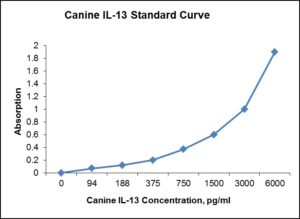Nori Canine IL-13 ELISA Kit
$508.00 – $916.00
This ELISA kit is for quantification of IL-13 in canine. This is a quick ELISA assay that reduces time to 50% compared to the conventional method, and the entire assay only takes 3 hours. This assay employs the quantitative sandwich enzyme immunoassay technique and uses biotin-streptavidin chemistry to improve the performance of the assays. An antibody specific for IL-13 has been pre-coated onto a microplate. Standards and samples are pipetted into the wells and any IL-13 present is bound by the immobilized antibody. After washing away any unbound substances, a detection antibody specific for IL-13 is added to the wells. Following wash to remove any unbound antibody reagent, a detection reagent is added. After intensive wash a substrate solution is added to the wells and color develops in proportion to the amount of IL-13 bound in the initial step. The color development is stopped, and the intensity of the color is measured.
Alternative names for IL-13: Interleukin 13, IL13
This product is for Laboratory Research Use Only not for diagnostic and therapeutic purposes or any other purposes.
- Description
- How Elisa Works
- Product Citation (0)
- Reviews (0)
Description
Nori Canine IL-13 ELISA Kit Summary
Alternative names for IL-13: Interleukin 13, IL13
Alternative name for canine: dog
| Assay Type | Solid Phase Sandwich ELISA |
| Format | 96-well Microplate or 96-Well Strip Microplate |
| Method of Detection | Colorimetric |
| Number of Targets Detected | 1 |
| Target Antigen Accession Number | Q9N0W9 |
| Assay Length | 3 hours |
| Quantitative/Semiquantitative | Quantitative |
| Sample Type | Plasma, Serum, Cell Culture, Urine, Cell/Tissue Lysates, Synovial Fluid, BAL, |
| Recommended Sample Dilution (Plasma/Serum) | No dilution for sample <ULOQ; sufficient dilution for samples >ULOQ |
| Sensitivity | 18 pg/mL |
| Detection Range | 94-6000 pg/mL |
| Specificity | Canine IL-13 |
| Cross-Reactivity | < 0.5% cross-reactivity observed with available related molecules, < 50% cross-species reactivity observed with species tested. |
| Interference | No significant interference observed with available related molecules |
| Storage/Stability | 4 ºC for up to 6 months |
| Usage | For Laboratory Research Use Only. Not for diagnostic or therapeutic use. |
| Additional Notes | The kit allows for use in multiple experiments. |
Standard Curve
Kit Components
1. Pre-coated 96-well Microplate
2. Biotinylated Detection Antibody
3. Streptavidin-HRP Conjugate
4. Lyophilized Standards
5. TMB One-Step Substrate
6. Stop Solution
7. 20 x PBS
8. Assay Buffer
Other Materials Required but not Provided:
1. Microplate Reader capable of measuring absorption at 450 nm
2. Log-log graph paper or computer and software for ELISA data analysis
3. Precision pipettes (1-1000 µl)
4. Multi-channel pipettes (300 µl)
5. Distilled or deionized water
Protocol Outline
1. Prepare all reagents, samples and standards as instructed in the datasheet.
2. Add 100 µl of Standard or samples to each well and incubate 1 h at RT.
3. Add 100 µl of Working Detection Antibody to each well and incubate 1 h at RT.
4. Add 100 µl of Working Streptavidin-HRP to each well and incubate 20 min at RT.
5. Add 100 µl of Substrate to each well and incubate 5-30 min at RT.
6. Add 50 µl of Stop Solution to each well and read at 450 nm immediately.
Background:
Interleukin 13 (IL-13) is a protein that in humans is encoded by the IL13 gene.[1][2][3] IL-13 is cytokine secreted by many cell types, but especially T helper type 2 (Th2) cells,[4] that is a mediator of allergic inflammation and disease. In addition to effects on immune cells that are similar to those of the closely related cytokine IL-4, IL-13 is more importantly implicated as a central mediator of the physiologic changes induced by allergic inflammation in many tissues. IL-13 induces its effects through a multi-subunit receptor that includes the alpha chain of the IL-4 receptor (IL-4Rα) and at least one of two known IL-13-specific binding chains.[4] The functions of IL-13 overlap considerably with those of IL-4, especially with regard to changes induced on hematopoietic cells, but these effects are probably less important given the more potent role of IL-4. Thus, although IL-13 can induce immunoglobulin E (IgE) secretion from activated human B cells. Rather than a lymphoid cytokine, IL-13 acts more prominently as a molecular bridge linking allergic inflammatory cells to the non-immune cells in contact with them, thereby altering physiological function. Although IL-13 is associated primarily with the induction of airway disease, it also has anti-inflammatory properties. Airway matrix metalloproteinases (MMPs), which are protein-degrading enzymes, are required to induce egression of effete parenchymal inflammatory cells into the airway lumen where they are then cleared. Among other factors, IL-13 induces these MMPs as part of a mechanism that protects against excessive allergic inflammation that predisposes to asphyxiation.
Reference
- Minty A, et al. (1993). Nature 362 (6417): 248–50.
- McKenzie AN, et al. (1993) Proc. Natl. Acad. Sci. U.S.A. 90 (8): 3735–9.
- Morgan JG, et al.. Nucleic Acids Res. 20 (19): 5173–9.
- Wynn TA (2003). “IL-13 effector functions”. Annu. Rev. Immunol. 21: 425–56.
Be the first to review “Nori Canine IL-13 ELISA Kit”
You must be logged in to post a review.




























Reviews
There are no reviews yet.